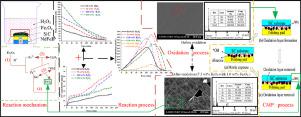当前位置:
X-MOL 学术
›
Surf. Interfaces
›
论文详情
Our official English website, www.x-mol.net, welcomes your
feedback! (Note: you will need to create a separate account there.)
The Mechanism of Fenton Reaction of Hydrogen Peroxide with Single Crystal 6H-SiC substrate
Surfaces and Interfaces ( IF 5.7 ) Pub Date : 2020-12-01 , DOI: 10.1016/j.surfin.2020.100730 Deng Jiayun , Pan Jisheng , Zhang Qixiang , Yan Qiusheng , Lu Jiabin
Surfaces and Interfaces ( IF 5.7 ) Pub Date : 2020-12-01 , DOI: 10.1016/j.surfin.2020.100730 Deng Jiayun , Pan Jisheng , Zhang Qixiang , Yan Qiusheng , Lu Jiabin

|
Abstract The strong oxidant hydroxyl radical (*OH) generated during Fenton reactions can be used for the chemical mechanical polishing (CMP) of single-crystal silicon carbide (SiC). In this study, we first determine the optimal concentration of the ferrosoferric oxide (Fe3O4) catalyst for the Fenton reaction. Then, we performed Fenton oxidation experiments on 6H-SiC substrates using five groups of reaction solution: hydrogen peroxide (H2O2) solution with four different initial concentrations (5.0, 7.5, 10.0, and 15.0 wt%) and with 1.0 wt% Fe3O4 catalyst and a solution containing 7.5 wt% H2O2 without a catalyst. The concentrations of H2O2, ferrous ions (Fe2+), iron ions (Fe3+), and *OH were monitored during the reaction. Moreover, the surface morphologies and elemental compositions of the SiC substrate before and after oxidation were analysed by scanning electron microscopy and energy dispersive spectroscopy. Finally, the specific components of the oxidation products were analysed by X-ray photoelectron spectroscopy to reveal the reaction mechanism of H2O2 with 6H-SiC. As the reaction proceeded, all the H2O2 concentrations decreased continuously, while the Fe3+ and Fe2+ concentrations increased. After the first 90 min, the H2O2 concentration decreased by approximately 50%–60%, while the Fe2+ concentration increased by approximately 50%–60%. Moreover, the *OH concentration initially increased and then decreased, and the *OH concentration reached its maximum within 100–120 min. At an initial H2O2 concentration of 7.5 wt% with 1.0 wt% Fe3O4, the maximum *OH concentration was approximately 54.4%, 11.8%, 42.5%, and 478% higher than those reached at an initial H2O2 concentration of 5.0, 10.0, and 15.0 wt% with 1.0 wt% Fe3O4 catalyst and in the solution containing 7.5 wt% H2O2 without catalyst, respectively. Surface oxide layers with different thicknesses were found on the SiC substrates oxidised with the different reaction solutions; the layers on the SiC substrates oxidised with 7.5 wt% H2O2 and 1.0 wt% Fe3O4 exhibited a favourable oxidation effect. The initial H2O2 concentration influenced the change in Fe3+, Fe2+, and *OH concentrations. This indicated that further affecting the oxidation effect on the SiC by generating more *OH leads to a greater oxidation effect. The *OH produced damaged the C-Si and C-C bonds on the SiC so that C and Si atoms were separately combined with O atoms to generate CO2 gaseous and SiO2 oxide layers. In this way, SiC substrates were oxidised and corroded, realising the CMP of the SiC with a high removal rate and low roughness.
中文翻译:

过氧化氢与单晶6H-SiC衬底的Fenton反应机理
摘要 Fenton反应产生的强氧化剂羟基自由基(*OH)可用于单晶碳化硅(SiC)的化学机械抛光(CMP)。在这项研究中,我们首先确定了用于芬顿反应的四氧化三铁 (Fe3O4) 催化剂的最佳浓度。然后,我们使用五组反应溶液在 6H-SiC 衬底上进行芬顿氧化实验:具有四种不同初始浓度(5.0、7.5、10.0 和 15.0 wt%)和 1.0 wt% Fe3O4 催化剂的过氧化氢 (H2O2) 溶液和不含催化剂的含 7.5 wt% H2O2 的溶液。在反应过程中监测 H2O2、亚铁离子 (Fe2+)、铁离子 (Fe3+) 和 *OH 的浓度。而且,通过扫描电子显微镜和能量色散光谱分析了氧化前后 SiC 衬底的表面形貌和元素组成。最后,通过 X 射线光电子能谱分析氧化产物的特定成分,揭示 H2O2 与 6H-SiC 的反应机理。随着反应的进行,所有的 H2O2 浓度不断降低,而 Fe3+ 和 Fe2+ 浓度增加。在最初的 90 分钟后,H2O2 浓度降低了大约 50%–60%,而 Fe2+ 浓度增加了大约 50%–60%。此外,*OH 浓度先升高后降低,*OH 浓度在 100-120 分钟内达到最大值。在初始 H2O2 浓度为 7.5 wt% 和 1.0 wt% Fe3O4 时,最大 *OH 浓度比初始 H2O2 浓度为 5.0、10.0 和 15.0 wt% 时达到的浓度高约 54.4%、11.8%、42.5% 和 478%,使用 1.0 wt% Fe3O4 催化剂并在含有 7.5 wt% Fe3O4 的溶液中% H2O2 没有催化剂,分别。在不同反应溶液氧化的SiC衬底上发现了不同厚度的表面氧化层;用 7.5 wt% H2O2 和 1.0 wt% Fe3O4 氧化的 SiC 衬底上的层表现出良好的氧化效果。初始 H2O2 浓度影响 Fe3+、Fe2+ 和 *OH 浓度的变化。这表明通过产生更多的 *OH 进一步影响 SiC 的氧化效果会导致更大的氧化效果。产生的 *OH 破坏了 SiC 上的 C-Si 和 CC 键,因此 C 和 Si 原子分别与 O 原子结合,生成 CO2 气态和 SiO2 氧化物层。通过这种方式,碳化硅衬底被氧化和腐蚀,实现了高去除率和低粗糙度的碳化硅CMP。
更新日期:2020-12-01
中文翻译:

过氧化氢与单晶6H-SiC衬底的Fenton反应机理
摘要 Fenton反应产生的强氧化剂羟基自由基(*OH)可用于单晶碳化硅(SiC)的化学机械抛光(CMP)。在这项研究中,我们首先确定了用于芬顿反应的四氧化三铁 (Fe3O4) 催化剂的最佳浓度。然后,我们使用五组反应溶液在 6H-SiC 衬底上进行芬顿氧化实验:具有四种不同初始浓度(5.0、7.5、10.0 和 15.0 wt%)和 1.0 wt% Fe3O4 催化剂的过氧化氢 (H2O2) 溶液和不含催化剂的含 7.5 wt% H2O2 的溶液。在反应过程中监测 H2O2、亚铁离子 (Fe2+)、铁离子 (Fe3+) 和 *OH 的浓度。而且,通过扫描电子显微镜和能量色散光谱分析了氧化前后 SiC 衬底的表面形貌和元素组成。最后,通过 X 射线光电子能谱分析氧化产物的特定成分,揭示 H2O2 与 6H-SiC 的反应机理。随着反应的进行,所有的 H2O2 浓度不断降低,而 Fe3+ 和 Fe2+ 浓度增加。在最初的 90 分钟后,H2O2 浓度降低了大约 50%–60%,而 Fe2+ 浓度增加了大约 50%–60%。此外,*OH 浓度先升高后降低,*OH 浓度在 100-120 分钟内达到最大值。在初始 H2O2 浓度为 7.5 wt% 和 1.0 wt% Fe3O4 时,最大 *OH 浓度比初始 H2O2 浓度为 5.0、10.0 和 15.0 wt% 时达到的浓度高约 54.4%、11.8%、42.5% 和 478%,使用 1.0 wt% Fe3O4 催化剂并在含有 7.5 wt% Fe3O4 的溶液中% H2O2 没有催化剂,分别。在不同反应溶液氧化的SiC衬底上发现了不同厚度的表面氧化层;用 7.5 wt% H2O2 和 1.0 wt% Fe3O4 氧化的 SiC 衬底上的层表现出良好的氧化效果。初始 H2O2 浓度影响 Fe3+、Fe2+ 和 *OH 浓度的变化。这表明通过产生更多的 *OH 进一步影响 SiC 的氧化效果会导致更大的氧化效果。产生的 *OH 破坏了 SiC 上的 C-Si 和 CC 键,因此 C 和 Si 原子分别与 O 原子结合,生成 CO2 气态和 SiO2 氧化物层。通过这种方式,碳化硅衬底被氧化和腐蚀,实现了高去除率和低粗糙度的碳化硅CMP。











































 京公网安备 11010802027423号
京公网安备 11010802027423号